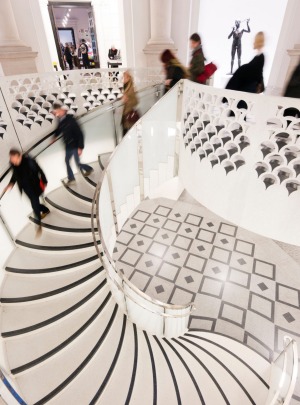
Once a stultifying swamp, then a prison for Australians' ancestors, Millbank, on London's Thames River, is home to London's latest glorious art reincarnation, the Tate Britain art gallery. The home of the Turner Prize, which turns 21 this year, the Tate Britain opened in 1897 as the National Gallery of British Art. The Tate Modern broke away from its fusty parent in 2000 to become the world's most popular museum, leaving the Tate Britain to languish, unloved, in its ultra-cool cousin's shadow. Now, a $86 million renovation has the gallery sparkling.
Instead of slinking round the side entrance like it's your dirty secret, the main Thames-facing entrance is once again open, so I strut boldly up the stairs and into the most beautiful atrium, crowned by a dramatic glass dome that has been hidden from view since the 1920s. The dome allows sunlight to pour into the elegant foyer and down a new spiral staircase. Visitors simply stop and stare at the architectural beauty, camera phones working hard.
The staircase leads to new galleries below, including two set aside for special exhibits. While entry into the regular collection is free, these two are not.
The new BP Walk through British Art steers you past 500 paintings, from severe portraits of the Tudor nobility of the early 1500s around to a modern installation of ethnographic totems. I'm reminded of the Aboriginal Memorial in the National Gallery of Australia, but peering into the gloom, I spot the head of Ronald McDonald … and is that a crucified Big Mac? It's The Chapman Family Collection, by artists Jake and Dinos Chapman.
We break for lunch, but because we're toting a toddler, the swish Whistler Restaurant with its restored 1927 Rex Whistler mural gets a miss. Instead, we bags a sofa amid Doric columns in the new Djanogly Cafe. Our open sandwiches of British salmon and blood-red rare roast beef are followed by coffee served with "Manners" double-ended teaspoons designed by artist Nicole Wermers. Word is they've quickly become a must-have souvenir for many light-fingered patrons.
Cool Britannia abounds: visitors snap favourite artworks on mobile phones, cruise the gallery with a mobile phone app, and a temporary gallery is stormed briefly by a gang of young schoolchildren wielding "More Art for Kids" placards.
If I had a gripe, it's because my favourite painting – and I'm an unashamed pre-Raphalite romantic – is lost in the busy 1840s room. Waterhouse's The Lady of Shalott is still pale and deathly beautiful, but what's she doing, alone and palely loitering high up in the gods? I almost miss her. But even if I did bypass her in the gallery, she's waiting for me at the gift shop – of course, one exits through the gift shop – she's zapped conveniently on to a fridge magnet. It just proves that while the renewed Tate Britain is tour-de-force of art curatorship, her feet are still on solid British soil.